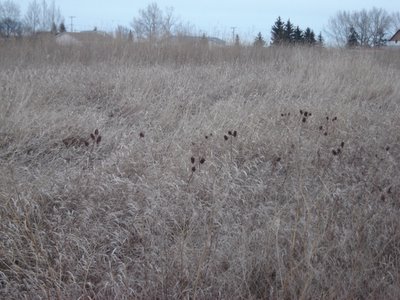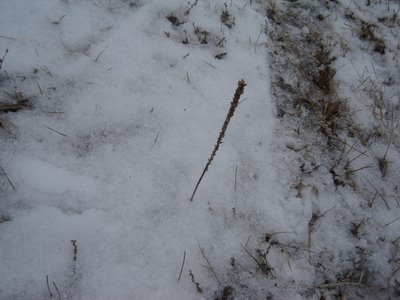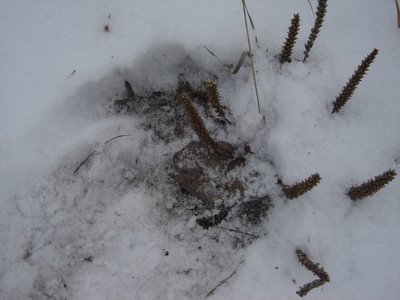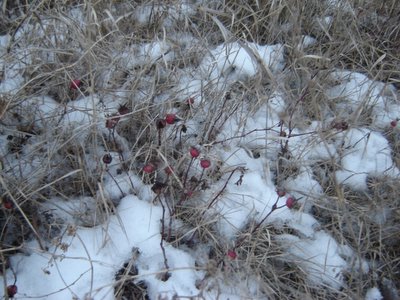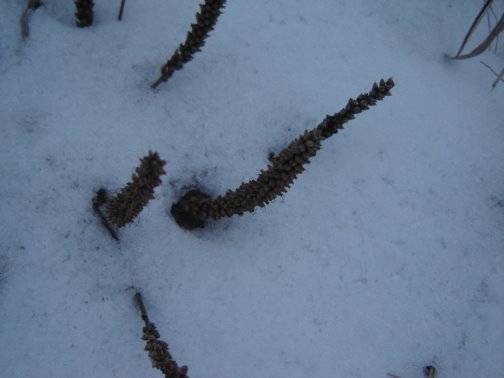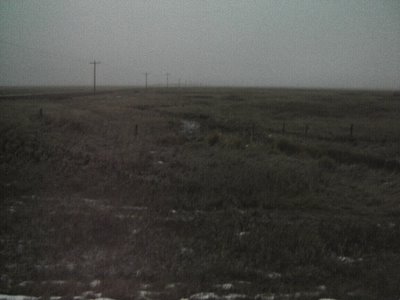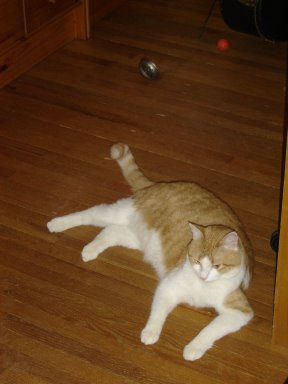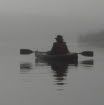is blue grama grass,
Bouteloua gracilis. It's a tough little survivor, often found on the drier hilltops and ridges around here, and forming a larger component of the short-grass prairie that occurs farther southwest.

The seed heads are very distinctive, like little combs or thick downcast eyelashes. I'm trying not to get into heavy terminology here, but it is really tough to describe the intricate flowering parts of a grass without using special words. Please take a deep breath and bear with me; I hope you will discover that you, too, can tease useful information out of the apparent gobbledygook of a systematic description in a flora. Here is the description from the Flora of the Great Plains (don't worry, I'll translate):
[for grama grasses in general:] Inflorescence consisting of 1-many spicate branches; spikelets sessile in 2 rows on one side of each branch rachis; each spikelet consisting of 1 perfect floret below 1 or 2 rudimentary florets, disarticulating above the glumes; . . .
[. . .]
[for blue grama grass in particular:] Inflorescence with 1-3 curved branches, each branch persistent, 14-30(40) mm long, bearing numerous spikelets; . . .
Ahem.
An "inflorescence" simply means a flowering portion of a plant. Well, that may be an oversimplification, but it will do to be getting on with. Going back to an
earlier post where I discussed daisies and dandelions and such: in those plants, one flower head is an inflorescence. It consists of a dense cluster of tiny flowers, and it may be only one inflorescence among many on a single plant. The term "inflorescence" draws attention to the arrangement of the individual flowers and other structures that go with them. Of course, in winter, we're not looking at flowers, but many of the parts remain in basically the same positions in the seed stage. Now before I do any more translation, I'll blend the above statements into one concise description of the flowering portion of a blue grama grass plant:
Inflorescence with 1-3 curved spicate branches; each branch persistent, 14-30(40) mm long, bearing numerous spikelets; spikelets sessile in 2 rows on one side of each branch rachis; each spikelet consisting of 1 perfect floret below 1 or 2 rudimentary florets, disarticulating above the glumes; . . .
"Spicate" just means spike-like, but we don't call it a spike because that term is reserved for the very simple arrangement where all the flowers are in one long cluster. In this case, the cluster may be all in one branch, or there may be several branches (which look like separate seed heads, but are all parts of a single inflorescence). Picky, aren't we? But with the hundreds of possible variations in different species, we have to be picky if we're going to communicate at all. So, when you look at the little comb above, you're looking at a spicate branch of the inflorescence.
"Persistent" means they don't fall off. Plants have all sorts of variations on the theme of dropping seeds, and each species has its own particular way of falling apart.
". . . bearing numerous spikelets . . ." Ah, more spiky stuff. You might think that each tooth in that little comb is a seed, but it's not. It's a seed plus other little parts attached to a tiny side branch. It's a spikelet: a "small or secondary spike." Recognizing these tiny sub-clusters of flowers (or seeds) is crucial to deciphering descriptions of grasses.
"Sessile" means "without a stalk." The spikelets are tight to the branch rachis. What's a rachis? It's the longitudinal support up the middle of a spike or spicate branch or such like. Basically the branch rachis is the branch itself, but the word "rachis" helps clarify where the spikelets are attached: along the branch, not at its tip or on side branches or anything fancy like that.
Speaking of a rachis, the description mentions that the spikelets are attached "in two rows on one side of [the] branch rachis." This is
important. This is what makes blue grama so distinctive in appearance that you don't really need all this description - you can just look at the picture and say, "I know that plant!" (But then there's hairy grama, which I've never seen, or at least, never noticed that I was seeing, which differs from blue grama by having the "rachis of [the] spicate branch projecting beyond the terminal spikelet," besides being just a little more hairy where the leaves meet the stems. . .) Anyway, notice that all the spikelets are crowded to one side of the spicate branch; that's what creates the appearance of a little comb.
When it says, "each spikelet consisting of 1 perfect floret. . ." this is where I say, "Bother. That stuff is too small to see anyway." I do have a dissecting scope, and I'm not afraid to use it, but we already know this is blue grama grass. I won't get into the minute details of individual grass flowers (or florets) today.
However, that last bit about "disarticulating above the glumes" is interesting, and it's something that you can easily check in the field without picking a plant, rushing home to your dissecting scope, and then finding out that you picked something rare. First, "disarticulating" means coming apart at the seams, er, joints. We're back to the topic of how plants fall apart. "Glumes" are bracts found at the base of a spikelet. "Above" means - wait, you do need to learn this word - "above" means farther from the roots, closer to the outermost tips of the plant. In the case of blue grama, it usually doesn't mean higher off the ground. The spikelet dangles, so it's closer to the ground than the glumes where it attaches, but we say the spikelet is "above" the glumes. When it falls off, the glumes remain attached to the branch rachis. Here is an inflorescence (centre of photo) with two spicate branches, and all the spikelets fallen, so all that remains are the slender glumes like a row of ribs.
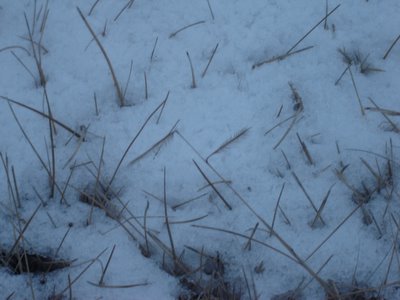
I've omitted a good deal of additional detail from the description, where it discusses how many nerves are in each glume, and what sort of awns are found on the parts of each floret - like I said, "Bother." But if I keep talking about grasses long enough, you're going to hear about the lemma and the palea, and I'll have to admit that you don't absolutely have to have a dissecting scope to find them; a hand lens and some patience will do.
Whew! Thanks for bearing with me through all that. Now we'll go back to some straightforward general-appearance qualities of blue grama grass. As you've probably noticed, it's usually a low-growing plant. Even the flowering stems are rarely more than about 30 cm tall around here, and the leaves are much shorter, forming a curly mat on the ground. The mat creeps outward in an expanding circle by short rhizomes (underground stems). Here is a rather small plant:

(the pale circular tuft below and left of centre). The silver-gray cottage-cheesy looking things behind it and to the lower right are mowed-off stems of pasture sage. (How do you like my botanical description for
that plant?) The dark stuff showing to the right of centre is not soil showing through. It's a dried up growth which my intuition says is
Nostoc, a nitrogen-fixing blue-green alga, but don't quote me on that. Feel free to correct me.
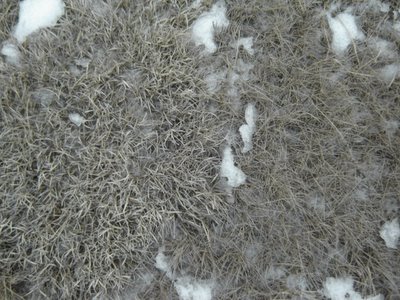
Here is another blue grama grass mat (on the left). Note the strongly curling leaves. Each one is only 1-2 mm wide. I suspect that the fine leaves and stems on the right belong to a dryland sedge species. What's a sedge? Well, for the most part, sedges are easily mistaken for grasses (unless you know what to look for). I say dryland, because sedges in general are known for their affinity for wetlands and damp habitats, but in our area there are just a few sedge species that have the opposite preference. You find them on those dry ridges and hilltops, along with blue grama grass, and growing only 5 or 6 cm tall. I've heard it said that short-grass prairie might be more properly called "short-sedge" prairie. As for the details of what to look for in a sedge, well, I think I'll leave that till I can catch one flowering in early, early spring. Wish me luck. This year, it looks like it could be tough to tell exactly when spring is.
Next in the series: you'll have to wait and see which way the muse takes me. Will I continue digging through my photos of grasses, or probe into the history of that vacant lot? Why so many native plants there? (Blue grama grass, sedge, prairie sage, and others I haven't mentioned yet.) Is it actually a degraded remnant of largely unbroken prairie sod? Or is it a once-disturbed but long-untouched piece of ground that was recolonized while there were still such remnants nearby? What part does it play in the ecology of our little townscape? What might its future hold?










